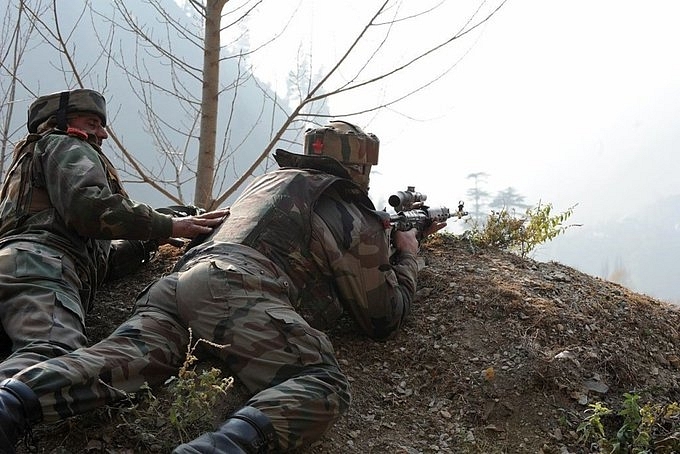News Brief
Explained: What It Takes To Guard The LOC Against Infiltration Bids By Pakistan Backed Terrorists

Indian soldiers (Source: @aloysius34/Twitter)
In the last two months, over 60 terrorists have infiltrated from the Pakistani side into India at LoC in Kashmir valley, while 20 terrorists have crossed over at LoC in south of Pir Panjal areas, the intelligence inputs revealed.
The terrorists infiltrated using the higher reaches of Gulmarg, Bandipora, and Boniyar in Baramulla and used Yusmarg to reach southern part of the state. This was also the route taken by Pakistan-backed tribal fighters that invaded Kashmir in 1947.
Reportedly, Bandipora-Gangbal-Chatergul route which was lying dormant for years has also been revived and terrorists are present in the upper reaches, based on the information given by Gujjars in the area.
The security agencies have now identified and sealed 20 such infiltration routes and put in place multi-tier security. The routes are in Kathua, Samba, Jammu, Rajouri, Poonch, Baramulla, Bandipora and Kupwara districts.
Indian response
Two/three tier security has been put in place with anti-infiltration obstacle system of border fencing.
The village defence committees (VDCs) along LoC and International Border and the police have been activated. Checkpoints have been installed for patrolling in hinterland near the border. Police stations and posts have been alerted to keep a tab on movement near the border.
Recently, National Security Adviser Ajit Doval had instructed the forces to put anti-infiltration grid along the border on high alert.
The BSF guarding the International border have strengthened their observation posts and listening posts to guard against intrusion through drones. The BSF is also patrolling riverine areas and water-patrol teams have been deployed at the Chenab river.
Why infiltration is hard to plug
The primary reason is the difficult terrain characterised by lofty mountains, several cross-border streams and dense growth of elephant grass.
Even high-tech equipment do not work in adverse climatic conditions and avalanche etc can damage the fencing and surveillance equipment.
“The terrorists are taking advantage of thick woods, dry nallahs, riverine and zero populated areas to infiltrate from PoK into Jammu and Kashmir”, an official was quoted as saying by TOI. In the past, cross-border tunnels were found being used by terrorists to cross over to India.
Former GOC of India’s Srinagar based 15 Corps, Syed Ata Hasnain has said that the three-way task of protection of posts and picquets, sanctity of the LoC (no encroachments or intrusions) and counter-infiltration poses a dilemma for the forces, which is further accentuated by ceasefire violations by Pakistan.
Counter-infiltration is also a manpower-intensive exercise and complete stopgap would require a soldier stationed at every 750 metre of the border.
Steps taken by India
India has constructed a 550-km fence along the 740-km Line of Control with the goal of excluding arms smuggling and infiltration by Pakistan. The fence was completed in 2004, one year after the ceasefire agreement, and the Indian army claimed that it brought down infiltration by 80 per cent.
The construction has double-row of fencing and 8–12-feet high concertina wire. It is electrified and connected to a network of motion sensors, thermal imaging devices, lighting systems and alarms so that the soldiers can be alerted and ambush the infiltrators trying to sneak in. The stretches of land between the rows of fencing has thousands of landmines.
In the 1980s in the backdrop of Punjab insurgency, India looked to employ high tech solutions to stop the infiltration. The BSF was provided with night surveillance capabilities such as Passive Night Vision Goggles (PNG), Night Weapon Sights (NWS), Hand Held Search Lights (HHSL), Hand Held Deep Search Metal Detectors (HHMD) etc.
As the threats increased in 1990s, more sophisticated devices such as Hand Held Thermal Imagery (HHTI) systems, Long Range Reconnaissance Observation Systems (LORROS), Battle Field Surveillance Radars (BFSR) were used.
However, the electronic surveillance system didn’t prove to be a panacea for the infiltration problem.
A review of the system in 2017 revealed significant gaps at rivers and nullahs running along the fences and the BSF troops over-stretched in guarding the border. It also highlighted the need for an integrated system that provides common operating picture at all levels.
Currently, the Indian government is in the process of implementing the Comprehensive Integrated Border Management System (CIBMS) which integrates human resources, weapons, and high-tech surveillance equipment.
In 2018, the defence ministry informed Rajya Sabha that innovative troop deployment, proactive use of surveillance and monitoring devices and the Anti-Infiltration Obstacle System were being used to detect and intercept terrorists attempting to infiltrate.
Support Swarajya's 50 Ground Reports Project & Sponsor A Story
Every general election Swarajya does a 50 ground reports project.
Aimed only at serious readers and those who appreciate the nuances of political undercurrents, the project provides a sense of India's electoral landscape. As you know, these reports are produced after considerable investment of travel, time and effort on the ground.
This time too we've kicked off the project in style and have covered over 30 constituencies already. If you're someone who appreciates such work and have enjoyed our coverage please consider sponsoring a ground report for just Rs 2999 to Rs 19,999 - it goes a long way in helping us produce more quality reportage.
You can also back this project by becoming a subscriber for as little as Rs 999 - so do click on this links and choose a plan that suits you and back us.
Click below to contribute.
Latest